Economic and Environmental Impacts of GM Crops in Developing Nations
VerifiedAdded on 2021/05/31
|13
|3206
|64
Report
AI Summary
This report investigates the multifaceted impacts of genetically modified (GM) crops, particularly within the context of developing nations. It explores the economic consequences, such as increased productivity, revenue, and reduced pesticide use for farmers, while also acknowledging potential drawbacks like rising seed prices due to patents and consumer cost concerns. Furthermore, the report delves into the environmental effects of GM crops, including reduced pesticide and herbicide use, decreased soil and water pollution, and a diminished carbon footprint. It also addresses the role of GM crops in water conservation and climate change mitigation. The report also discusses the regulations surrounding genetically modified organisms (GMOs), highlighting the varying approaches of different countries and the importance of risk assessment and safety regulations to protect both human health and the environment.
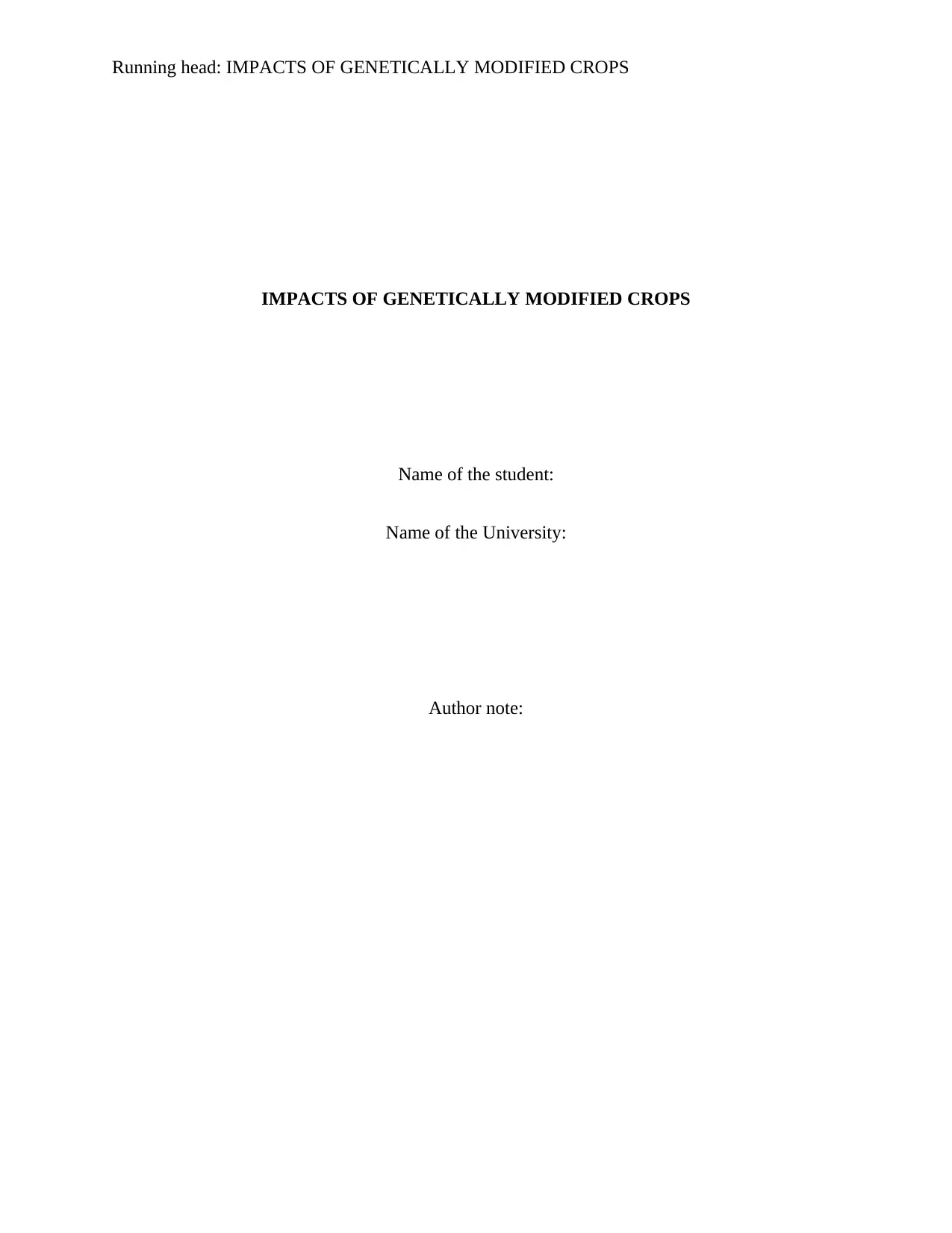
Running head: IMPACTS OF GENETICALLY MODIFIED CROPS
IMPACTS OF GENETICALLY MODIFIED CROPS
Name of the student:
Name of the University:
Author note:
IMPACTS OF GENETICALLY MODIFIED CROPS
Name of the student:
Name of the University:
Author note:
Paraphrase This Document
Need a fresh take? Get an instant paraphrase of this document with our AI Paraphraser

1IMPACTS OF GENETICALLY MODIFIED CROPS
The genetically modified crops or GM crops are defined as the crops that are modified
through genetic engineering. The DNA of the crops is modified in order to provide new
characteristics to the plant, which is not present in the species naturally1. Such improved
characteristics include resistance to harmful pesticide and herbicide, resistance to some extreme
environmental condition, Improvement of nutrient provided by the crop, less spoilage and any
others. The most common genetically modified crops include corn, soy, alfalfa, canola, zucchini
and sugar beets. According to researchers, genetically modified crops have no grater harm
factors than common food. It is important to examine the GM crops case-by-case prior to the
introduction in the market2. Introduction of GM crops helps to increase the productivity of the
agriculture and reduces the use of harmful pesticides. However, there are some cons of using
GM crops, for example, it can cause hazards to the health condition of individual such as
allergies from toxicity3. Due to such issue some countries restrict the access of GM crops, where
as some nations allow the access of Gm crops with appropriate regulations. It is notified by some
experts that, in the developing countries, profit is higher due to GM crops than the developed
countries. The research paper will focus on the impacts of GM crops on the economy and
environment of the developing countries and will provide information regarding the regulation of
genetically modified organisms or GMO.
The genetically modified crops are spreading rapidly across the world and people are
accepting the technology of genetic engineering in order to improve the traits of natural crops. It
is one of the most researchable facts in the modern society and researchers are trying to improve
their study in order to bring innovation regarding the GM crops. `The government and the
1 Barrows, Geoffrey, Steven Sexton, and David Zilberman. "Agricultural biotechnology: the promise and prospects
of genetically modified crops." Journal of Economic Perspectives28.1 (2014): 99-120.
2 Kamle, Suchitra, and Sher Ali. "Genetically modified crops: detection strategies and biosafety issues." Gene 522.2
(2013): 123-132.
3 Hakim, Danny. "Doubts about the promised bounty of genetically modified crops." New York Times 29 (2016).
The genetically modified crops or GM crops are defined as the crops that are modified
through genetic engineering. The DNA of the crops is modified in order to provide new
characteristics to the plant, which is not present in the species naturally1. Such improved
characteristics include resistance to harmful pesticide and herbicide, resistance to some extreme
environmental condition, Improvement of nutrient provided by the crop, less spoilage and any
others. The most common genetically modified crops include corn, soy, alfalfa, canola, zucchini
and sugar beets. According to researchers, genetically modified crops have no grater harm
factors than common food. It is important to examine the GM crops case-by-case prior to the
introduction in the market2. Introduction of GM crops helps to increase the productivity of the
agriculture and reduces the use of harmful pesticides. However, there are some cons of using
GM crops, for example, it can cause hazards to the health condition of individual such as
allergies from toxicity3. Due to such issue some countries restrict the access of GM crops, where
as some nations allow the access of Gm crops with appropriate regulations. It is notified by some
experts that, in the developing countries, profit is higher due to GM crops than the developed
countries. The research paper will focus on the impacts of GM crops on the economy and
environment of the developing countries and will provide information regarding the regulation of
genetically modified organisms or GMO.
The genetically modified crops are spreading rapidly across the world and people are
accepting the technology of genetic engineering in order to improve the traits of natural crops. It
is one of the most researchable facts in the modern society and researchers are trying to improve
their study in order to bring innovation regarding the GM crops. `The government and the
1 Barrows, Geoffrey, Steven Sexton, and David Zilberman. "Agricultural biotechnology: the promise and prospects
of genetically modified crops." Journal of Economic Perspectives28.1 (2014): 99-120.
2 Kamle, Suchitra, and Sher Ali. "Genetically modified crops: detection strategies and biosafety issues." Gene 522.2
(2013): 123-132.
3 Hakim, Danny. "Doubts about the promised bounty of genetically modified crops." New York Times 29 (2016).
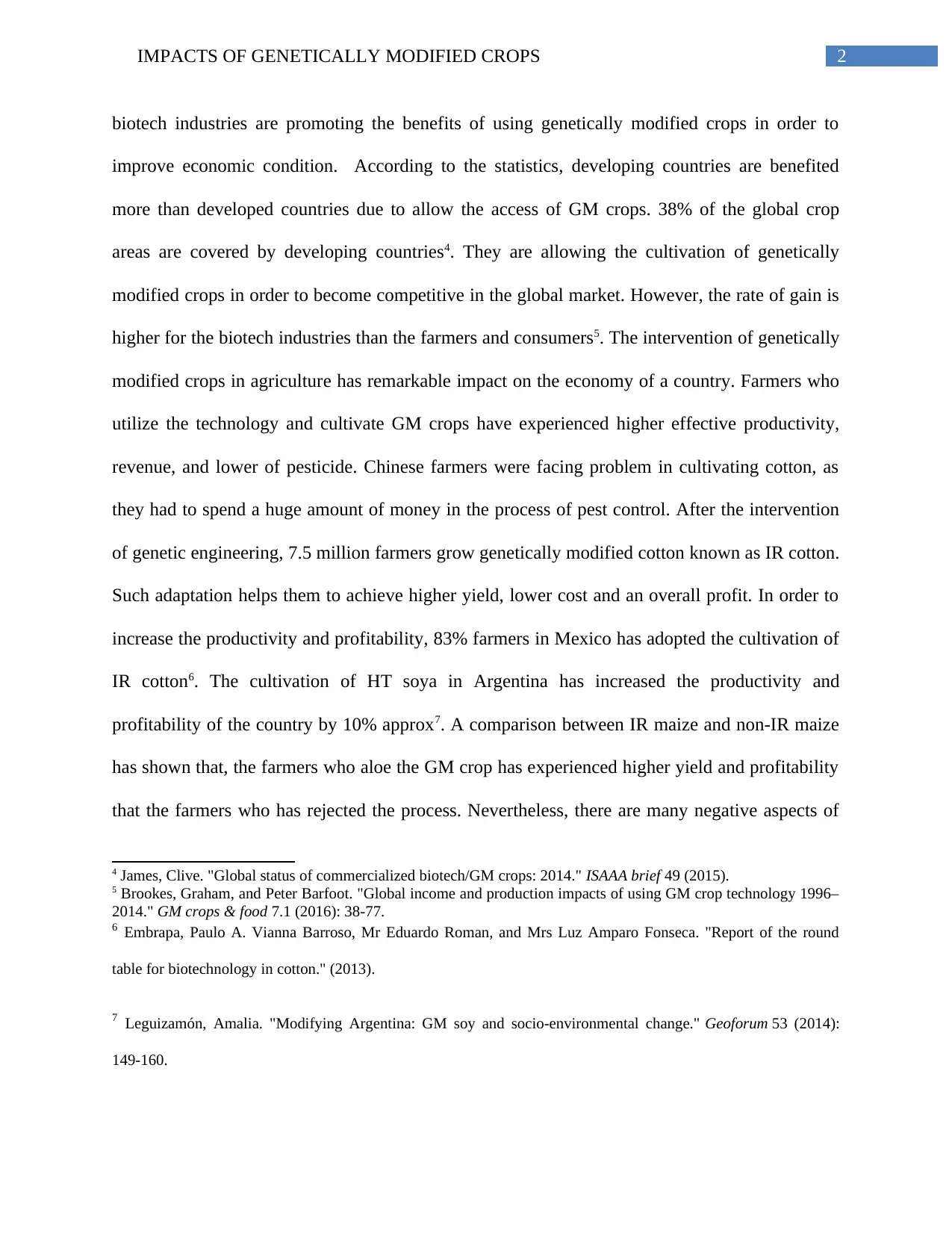
2IMPACTS OF GENETICALLY MODIFIED CROPS
biotech industries are promoting the benefits of using genetically modified crops in order to
improve economic condition. According to the statistics, developing countries are benefited
more than developed countries due to allow the access of GM crops. 38% of the global crop
areas are covered by developing countries4. They are allowing the cultivation of genetically
modified crops in order to become competitive in the global market. However, the rate of gain is
higher for the biotech industries than the farmers and consumers5. The intervention of genetically
modified crops in agriculture has remarkable impact on the economy of a country. Farmers who
utilize the technology and cultivate GM crops have experienced higher effective productivity,
revenue, and lower of pesticide. Chinese farmers were facing problem in cultivating cotton, as
they had to spend a huge amount of money in the process of pest control. After the intervention
of genetic engineering, 7.5 million farmers grow genetically modified cotton known as IR cotton.
Such adaptation helps them to achieve higher yield, lower cost and an overall profit. In order to
increase the productivity and profitability, 83% farmers in Mexico has adopted the cultivation of
IR cotton6. The cultivation of HT soya in Argentina has increased the productivity and
profitability of the country by 10% approx7. A comparison between IR maize and non-IR maize
has shown that, the farmers who aloe the GM crop has experienced higher yield and profitability
that the farmers who has rejected the process. Nevertheless, there are many negative aspects of
4 James, Clive. "Global status of commercialized biotech/GM crops: 2014." ISAAA brief 49 (2015).
5 Brookes, Graham, and Peter Barfoot. "Global income and production impacts of using GM crop technology 1996–
2014." GM crops & food 7.1 (2016): 38-77.
6 Embrapa, Paulo A. Vianna Barroso, Mr Eduardo Roman, and Mrs Luz Amparo Fonseca. "Report of the round
table for biotechnology in cotton." (2013).
7 Leguizamón, Amalia. "Modifying Argentina: GM soy and socio-environmental change." Geoforum 53 (2014):
149-160.
biotech industries are promoting the benefits of using genetically modified crops in order to
improve economic condition. According to the statistics, developing countries are benefited
more than developed countries due to allow the access of GM crops. 38% of the global crop
areas are covered by developing countries4. They are allowing the cultivation of genetically
modified crops in order to become competitive in the global market. However, the rate of gain is
higher for the biotech industries than the farmers and consumers5. The intervention of genetically
modified crops in agriculture has remarkable impact on the economy of a country. Farmers who
utilize the technology and cultivate GM crops have experienced higher effective productivity,
revenue, and lower of pesticide. Chinese farmers were facing problem in cultivating cotton, as
they had to spend a huge amount of money in the process of pest control. After the intervention
of genetic engineering, 7.5 million farmers grow genetically modified cotton known as IR cotton.
Such adaptation helps them to achieve higher yield, lower cost and an overall profit. In order to
increase the productivity and profitability, 83% farmers in Mexico has adopted the cultivation of
IR cotton6. The cultivation of HT soya in Argentina has increased the productivity and
profitability of the country by 10% approx7. A comparison between IR maize and non-IR maize
has shown that, the farmers who aloe the GM crop has experienced higher yield and profitability
that the farmers who has rejected the process. Nevertheless, there are many negative aspects of
4 James, Clive. "Global status of commercialized biotech/GM crops: 2014." ISAAA brief 49 (2015).
5 Brookes, Graham, and Peter Barfoot. "Global income and production impacts of using GM crop technology 1996–
2014." GM crops & food 7.1 (2016): 38-77.
6 Embrapa, Paulo A. Vianna Barroso, Mr Eduardo Roman, and Mrs Luz Amparo Fonseca. "Report of the round
table for biotechnology in cotton." (2013).
7 Leguizamón, Amalia. "Modifying Argentina: GM soy and socio-environmental change." Geoforum 53 (2014):
149-160.
⊘ This is a preview!⊘
Do you want full access?
Subscribe today to unlock all pages.

Trusted by 1+ million students worldwide
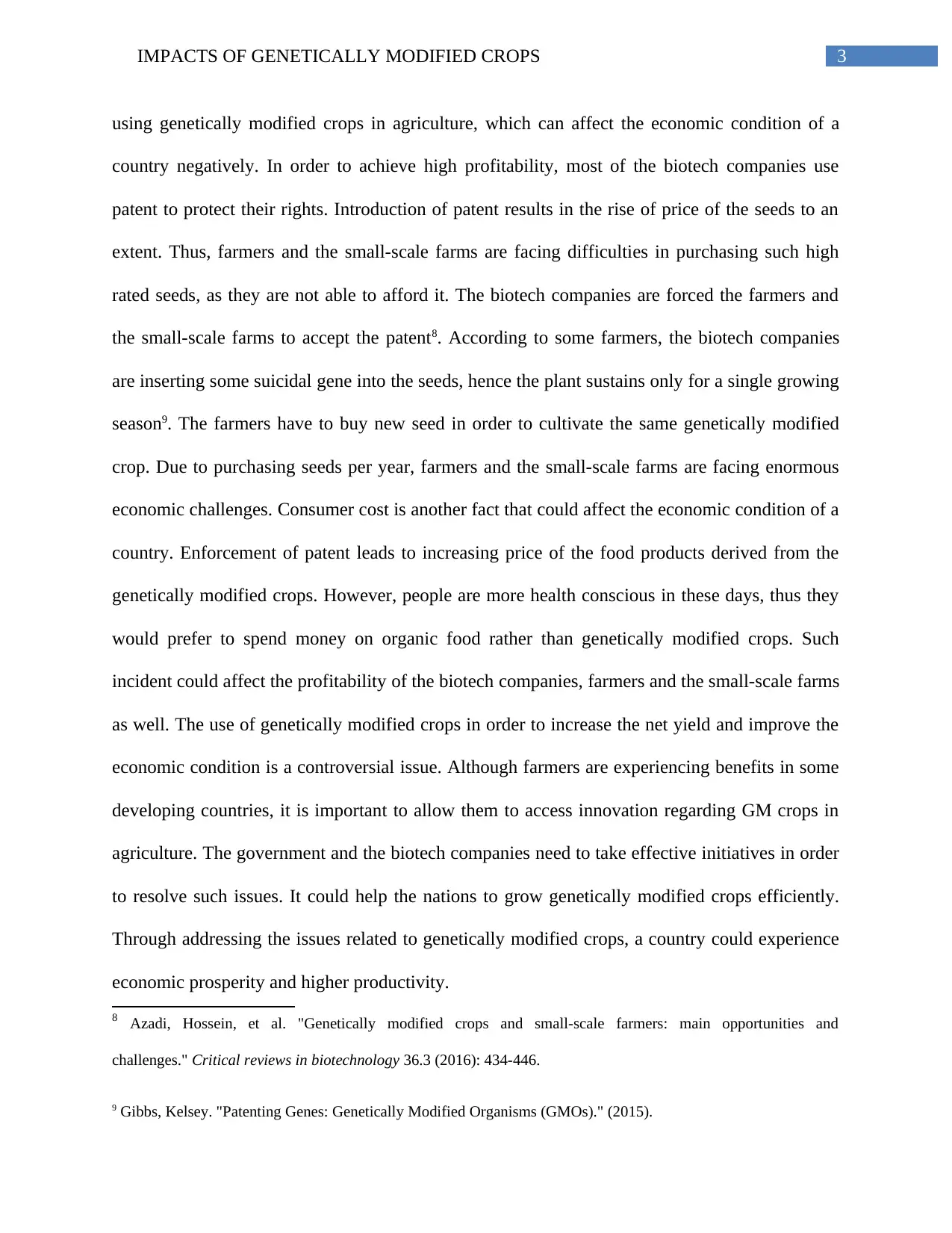
3IMPACTS OF GENETICALLY MODIFIED CROPS
using genetically modified crops in agriculture, which can affect the economic condition of a
country negatively. In order to achieve high profitability, most of the biotech companies use
patent to protect their rights. Introduction of patent results in the rise of price of the seeds to an
extent. Thus, farmers and the small-scale farms are facing difficulties in purchasing such high
rated seeds, as they are not able to afford it. The biotech companies are forced the farmers and
the small-scale farms to accept the patent8. According to some farmers, the biotech companies
are inserting some suicidal gene into the seeds, hence the plant sustains only for a single growing
season9. The farmers have to buy new seed in order to cultivate the same genetically modified
crop. Due to purchasing seeds per year, farmers and the small-scale farms are facing enormous
economic challenges. Consumer cost is another fact that could affect the economic condition of a
country. Enforcement of patent leads to increasing price of the food products derived from the
genetically modified crops. However, people are more health conscious in these days, thus they
would prefer to spend money on organic food rather than genetically modified crops. Such
incident could affect the profitability of the biotech companies, farmers and the small-scale farms
as well. The use of genetically modified crops in order to increase the net yield and improve the
economic condition is a controversial issue. Although farmers are experiencing benefits in some
developing countries, it is important to allow them to access innovation regarding GM crops in
agriculture. The government and the biotech companies need to take effective initiatives in order
to resolve such issues. It could help the nations to grow genetically modified crops efficiently.
Through addressing the issues related to genetically modified crops, a country could experience
economic prosperity and higher productivity.
8 Azadi, Hossein, et al. "Genetically modified crops and small-scale farmers: main opportunities and
challenges." Critical reviews in biotechnology 36.3 (2016): 434-446.
9 Gibbs, Kelsey. "Patenting Genes: Genetically Modified Organisms (GMOs)." (2015).
using genetically modified crops in agriculture, which can affect the economic condition of a
country negatively. In order to achieve high profitability, most of the biotech companies use
patent to protect their rights. Introduction of patent results in the rise of price of the seeds to an
extent. Thus, farmers and the small-scale farms are facing difficulties in purchasing such high
rated seeds, as they are not able to afford it. The biotech companies are forced the farmers and
the small-scale farms to accept the patent8. According to some farmers, the biotech companies
are inserting some suicidal gene into the seeds, hence the plant sustains only for a single growing
season9. The farmers have to buy new seed in order to cultivate the same genetically modified
crop. Due to purchasing seeds per year, farmers and the small-scale farms are facing enormous
economic challenges. Consumer cost is another fact that could affect the economic condition of a
country. Enforcement of patent leads to increasing price of the food products derived from the
genetically modified crops. However, people are more health conscious in these days, thus they
would prefer to spend money on organic food rather than genetically modified crops. Such
incident could affect the profitability of the biotech companies, farmers and the small-scale farms
as well. The use of genetically modified crops in order to increase the net yield and improve the
economic condition is a controversial issue. Although farmers are experiencing benefits in some
developing countries, it is important to allow them to access innovation regarding GM crops in
agriculture. The government and the biotech companies need to take effective initiatives in order
to resolve such issues. It could help the nations to grow genetically modified crops efficiently.
Through addressing the issues related to genetically modified crops, a country could experience
economic prosperity and higher productivity.
8 Azadi, Hossein, et al. "Genetically modified crops and small-scale farmers: main opportunities and
challenges." Critical reviews in biotechnology 36.3 (2016): 434-446.
9 Gibbs, Kelsey. "Patenting Genes: Genetically Modified Organisms (GMOs)." (2015).
Paraphrase This Document
Need a fresh take? Get an instant paraphrase of this document with our AI Paraphraser
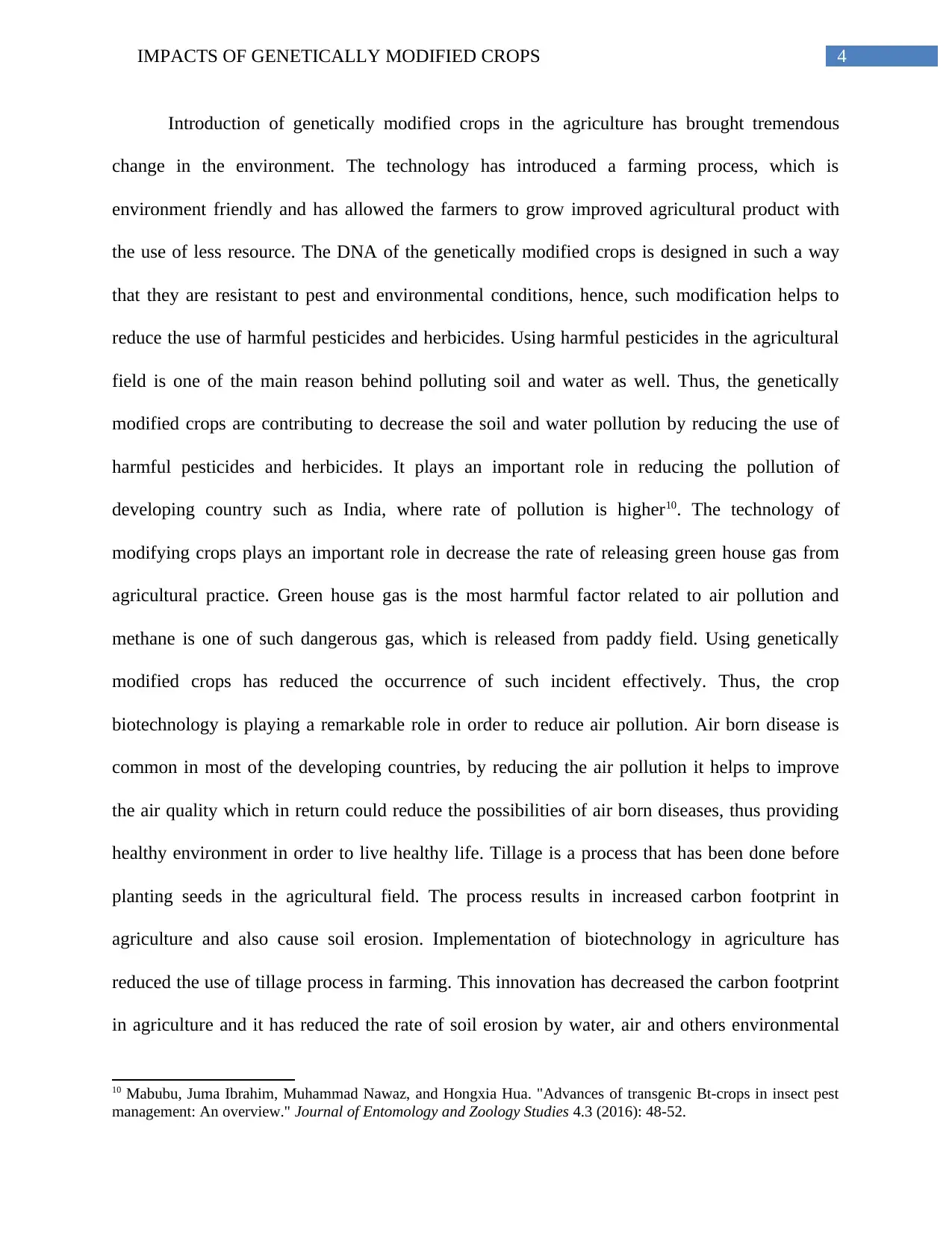
4IMPACTS OF GENETICALLY MODIFIED CROPS
Introduction of genetically modified crops in the agriculture has brought tremendous
change in the environment. The technology has introduced a farming process, which is
environment friendly and has allowed the farmers to grow improved agricultural product with
the use of less resource. The DNA of the genetically modified crops is designed in such a way
that they are resistant to pest and environmental conditions, hence, such modification helps to
reduce the use of harmful pesticides and herbicides. Using harmful pesticides in the agricultural
field is one of the main reason behind polluting soil and water as well. Thus, the genetically
modified crops are contributing to decrease the soil and water pollution by reducing the use of
harmful pesticides and herbicides. It plays an important role in reducing the pollution of
developing country such as India, where rate of pollution is higher10. The technology of
modifying crops plays an important role in decrease the rate of releasing green house gas from
agricultural practice. Green house gas is the most harmful factor related to air pollution and
methane is one of such dangerous gas, which is released from paddy field. Using genetically
modified crops has reduced the occurrence of such incident effectively. Thus, the crop
biotechnology is playing a remarkable role in order to reduce air pollution. Air born disease is
common in most of the developing countries, by reducing the air pollution it helps to improve
the air quality which in return could reduce the possibilities of air born diseases, thus providing
healthy environment in order to live healthy life. Tillage is a process that has been done before
planting seeds in the agricultural field. The process results in increased carbon footprint in
agriculture and also cause soil erosion. Implementation of biotechnology in agriculture has
reduced the use of tillage process in farming. This innovation has decreased the carbon footprint
in agriculture and it has reduced the rate of soil erosion by water, air and others environmental
10 Mabubu, Juma Ibrahim, Muhammad Nawaz, and Hongxia Hua. "Advances of transgenic Bt-crops in insect pest
management: An overview." Journal of Entomology and Zoology Studies 4.3 (2016): 48-52.
Introduction of genetically modified crops in the agriculture has brought tremendous
change in the environment. The technology has introduced a farming process, which is
environment friendly and has allowed the farmers to grow improved agricultural product with
the use of less resource. The DNA of the genetically modified crops is designed in such a way
that they are resistant to pest and environmental conditions, hence, such modification helps to
reduce the use of harmful pesticides and herbicides. Using harmful pesticides in the agricultural
field is one of the main reason behind polluting soil and water as well. Thus, the genetically
modified crops are contributing to decrease the soil and water pollution by reducing the use of
harmful pesticides and herbicides. It plays an important role in reducing the pollution of
developing country such as India, where rate of pollution is higher10. The technology of
modifying crops plays an important role in decrease the rate of releasing green house gas from
agricultural practice. Green house gas is the most harmful factor related to air pollution and
methane is one of such dangerous gas, which is released from paddy field. Using genetically
modified crops has reduced the occurrence of such incident effectively. Thus, the crop
biotechnology is playing a remarkable role in order to reduce air pollution. Air born disease is
common in most of the developing countries, by reducing the air pollution it helps to improve
the air quality which in return could reduce the possibilities of air born diseases, thus providing
healthy environment in order to live healthy life. Tillage is a process that has been done before
planting seeds in the agricultural field. The process results in increased carbon footprint in
agriculture and also cause soil erosion. Implementation of biotechnology in agriculture has
reduced the use of tillage process in farming. This innovation has decreased the carbon footprint
in agriculture and it has reduced the rate of soil erosion by water, air and others environmental
10 Mabubu, Juma Ibrahim, Muhammad Nawaz, and Hongxia Hua. "Advances of transgenic Bt-crops in insect pest
management: An overview." Journal of Entomology and Zoology Studies 4.3 (2016): 48-52.
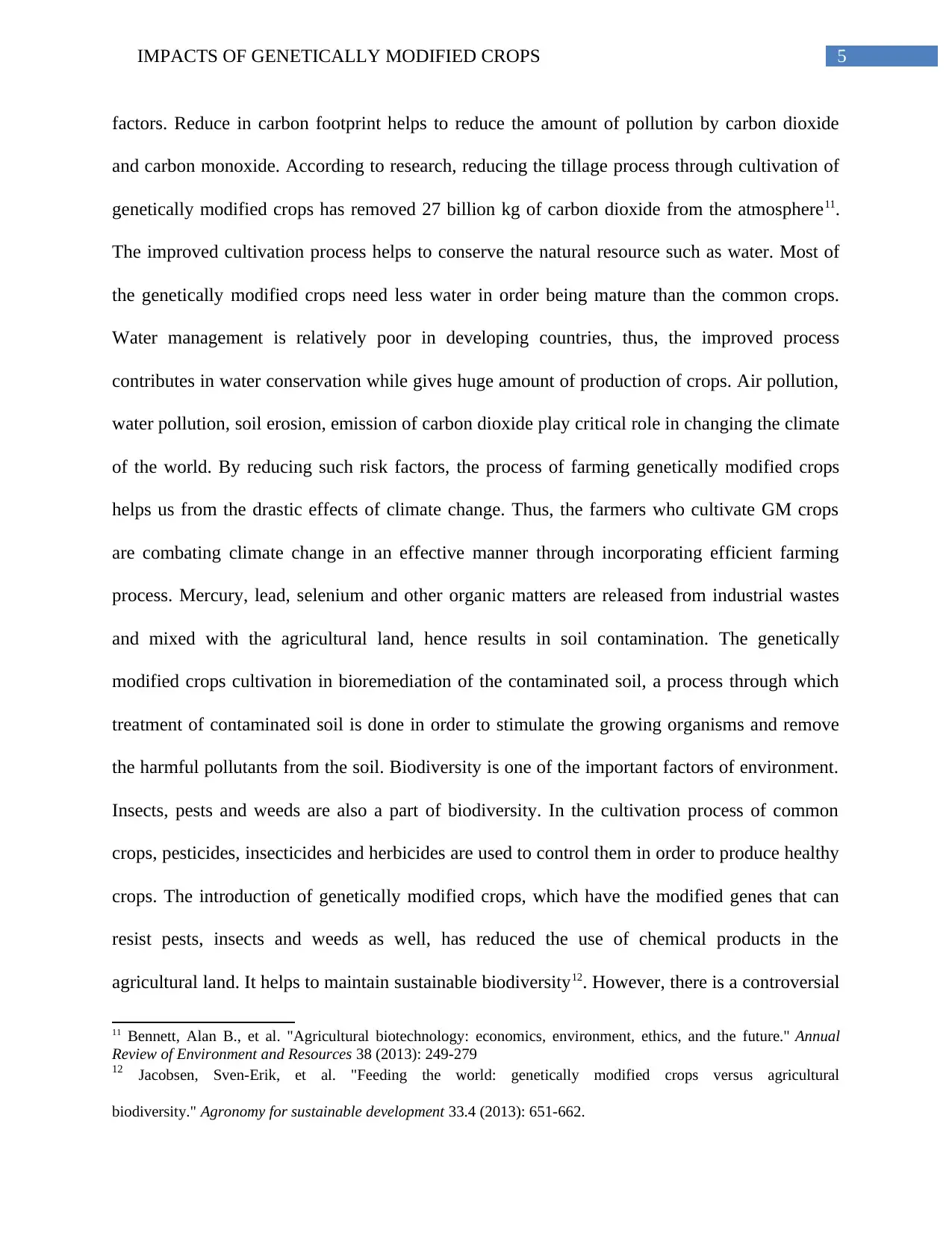
5IMPACTS OF GENETICALLY MODIFIED CROPS
factors. Reduce in carbon footprint helps to reduce the amount of pollution by carbon dioxide
and carbon monoxide. According to research, reducing the tillage process through cultivation of
genetically modified crops has removed 27 billion kg of carbon dioxide from the atmosphere11.
The improved cultivation process helps to conserve the natural resource such as water. Most of
the genetically modified crops need less water in order being mature than the common crops.
Water management is relatively poor in developing countries, thus, the improved process
contributes in water conservation while gives huge amount of production of crops. Air pollution,
water pollution, soil erosion, emission of carbon dioxide play critical role in changing the climate
of the world. By reducing such risk factors, the process of farming genetically modified crops
helps us from the drastic effects of climate change. Thus, the farmers who cultivate GM crops
are combating climate change in an effective manner through incorporating efficient farming
process. Mercury, lead, selenium and other organic matters are released from industrial wastes
and mixed with the agricultural land, hence results in soil contamination. The genetically
modified crops cultivation in bioremediation of the contaminated soil, a process through which
treatment of contaminated soil is done in order to stimulate the growing organisms and remove
the harmful pollutants from the soil. Biodiversity is one of the important factors of environment.
Insects, pests and weeds are also a part of biodiversity. In the cultivation process of common
crops, pesticides, insecticides and herbicides are used to control them in order to produce healthy
crops. The introduction of genetically modified crops, which have the modified genes that can
resist pests, insects and weeds as well, has reduced the use of chemical products in the
agricultural land. It helps to maintain sustainable biodiversity12. However, there is a controversial
11 Bennett, Alan B., et al. "Agricultural biotechnology: economics, environment, ethics, and the future." Annual
Review of Environment and Resources 38 (2013): 249-279
12 Jacobsen, Sven-Erik, et al. "Feeding the world: genetically modified crops versus agricultural
biodiversity." Agronomy for sustainable development 33.4 (2013): 651-662.
factors. Reduce in carbon footprint helps to reduce the amount of pollution by carbon dioxide
and carbon monoxide. According to research, reducing the tillage process through cultivation of
genetically modified crops has removed 27 billion kg of carbon dioxide from the atmosphere11.
The improved cultivation process helps to conserve the natural resource such as water. Most of
the genetically modified crops need less water in order being mature than the common crops.
Water management is relatively poor in developing countries, thus, the improved process
contributes in water conservation while gives huge amount of production of crops. Air pollution,
water pollution, soil erosion, emission of carbon dioxide play critical role in changing the climate
of the world. By reducing such risk factors, the process of farming genetically modified crops
helps us from the drastic effects of climate change. Thus, the farmers who cultivate GM crops
are combating climate change in an effective manner through incorporating efficient farming
process. Mercury, lead, selenium and other organic matters are released from industrial wastes
and mixed with the agricultural land, hence results in soil contamination. The genetically
modified crops cultivation in bioremediation of the contaminated soil, a process through which
treatment of contaminated soil is done in order to stimulate the growing organisms and remove
the harmful pollutants from the soil. Biodiversity is one of the important factors of environment.
Insects, pests and weeds are also a part of biodiversity. In the cultivation process of common
crops, pesticides, insecticides and herbicides are used to control them in order to produce healthy
crops. The introduction of genetically modified crops, which have the modified genes that can
resist pests, insects and weeds as well, has reduced the use of chemical products in the
agricultural land. It helps to maintain sustainable biodiversity12. However, there is a controversial
11 Bennett, Alan B., et al. "Agricultural biotechnology: economics, environment, ethics, and the future." Annual
Review of Environment and Resources 38 (2013): 249-279
12 Jacobsen, Sven-Erik, et al. "Feeding the world: genetically modified crops versus agricultural
biodiversity." Agronomy for sustainable development 33.4 (2013): 651-662.
⊘ This is a preview!⊘
Do you want full access?
Subscribe today to unlock all pages.

Trusted by 1+ million students worldwide
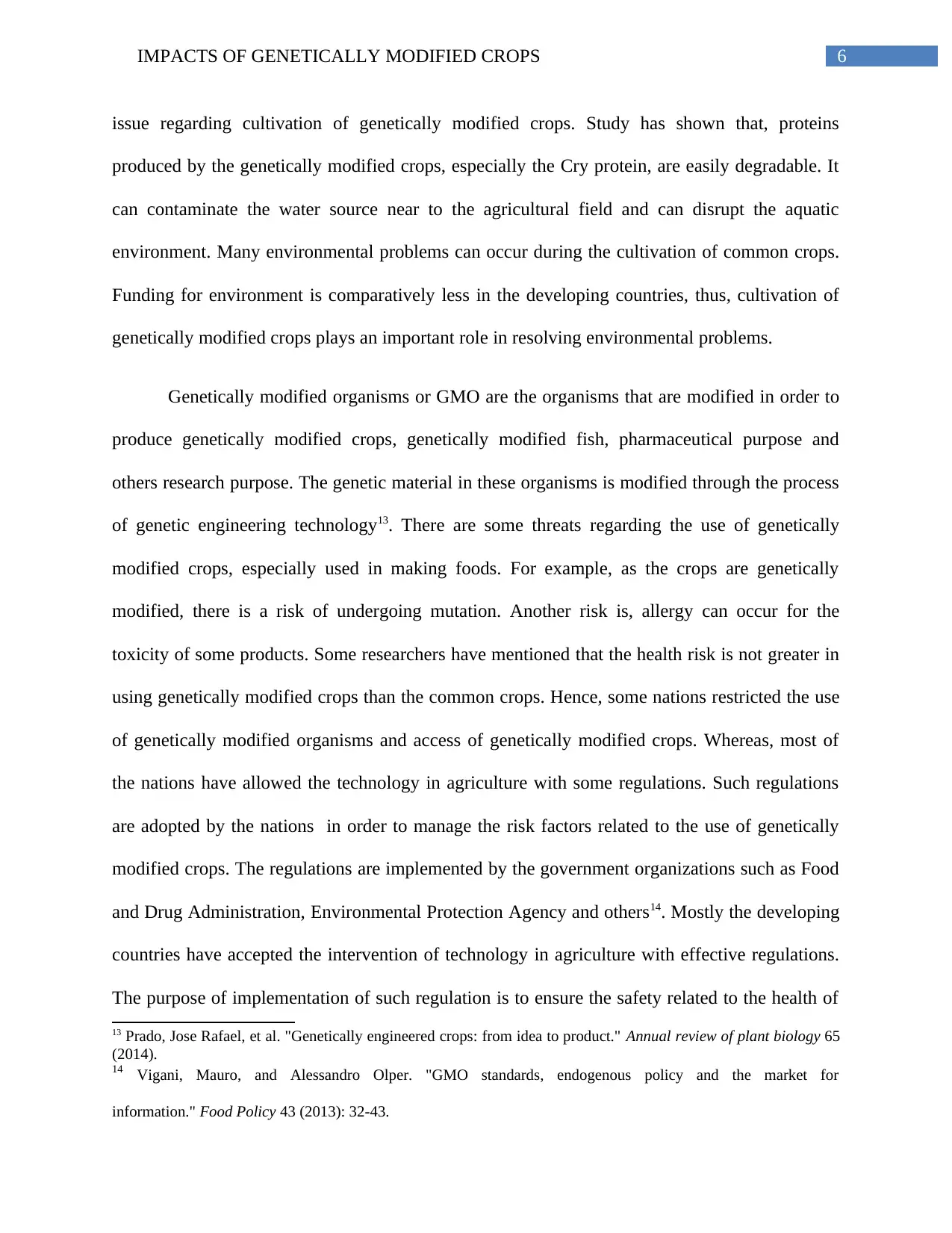
6IMPACTS OF GENETICALLY MODIFIED CROPS
issue regarding cultivation of genetically modified crops. Study has shown that, proteins
produced by the genetically modified crops, especially the Cry protein, are easily degradable. It
can contaminate the water source near to the agricultural field and can disrupt the aquatic
environment. Many environmental problems can occur during the cultivation of common crops.
Funding for environment is comparatively less in the developing countries, thus, cultivation of
genetically modified crops plays an important role in resolving environmental problems.
Genetically modified organisms or GMO are the organisms that are modified in order to
produce genetically modified crops, genetically modified fish, pharmaceutical purpose and
others research purpose. The genetic material in these organisms is modified through the process
of genetic engineering technology13. There are some threats regarding the use of genetically
modified crops, especially used in making foods. For example, as the crops are genetically
modified, there is a risk of undergoing mutation. Another risk is, allergy can occur for the
toxicity of some products. Some researchers have mentioned that the health risk is not greater in
using genetically modified crops than the common crops. Hence, some nations restricted the use
of genetically modified organisms and access of genetically modified crops. Whereas, most of
the nations have allowed the technology in agriculture with some regulations. Such regulations
are adopted by the nations in order to manage the risk factors related to the use of genetically
modified crops. The regulations are implemented by the government organizations such as Food
and Drug Administration, Environmental Protection Agency and others14. Mostly the developing
countries have accepted the intervention of technology in agriculture with effective regulations.
The purpose of implementation of such regulation is to ensure the safety related to the health of
13 Prado, Jose Rafael, et al. "Genetically engineered crops: from idea to product." Annual review of plant biology 65
(2014).
14 Vigani, Mauro, and Alessandro Olper. "GMO standards, endogenous policy and the market for
information." Food Policy 43 (2013): 32-43.
issue regarding cultivation of genetically modified crops. Study has shown that, proteins
produced by the genetically modified crops, especially the Cry protein, are easily degradable. It
can contaminate the water source near to the agricultural field and can disrupt the aquatic
environment. Many environmental problems can occur during the cultivation of common crops.
Funding for environment is comparatively less in the developing countries, thus, cultivation of
genetically modified crops plays an important role in resolving environmental problems.
Genetically modified organisms or GMO are the organisms that are modified in order to
produce genetically modified crops, genetically modified fish, pharmaceutical purpose and
others research purpose. The genetic material in these organisms is modified through the process
of genetic engineering technology13. There are some threats regarding the use of genetically
modified crops, especially used in making foods. For example, as the crops are genetically
modified, there is a risk of undergoing mutation. Another risk is, allergy can occur for the
toxicity of some products. Some researchers have mentioned that the health risk is not greater in
using genetically modified crops than the common crops. Hence, some nations restricted the use
of genetically modified organisms and access of genetically modified crops. Whereas, most of
the nations have allowed the technology in agriculture with some regulations. Such regulations
are adopted by the nations in order to manage the risk factors related to the use of genetically
modified crops. The regulations are implemented by the government organizations such as Food
and Drug Administration, Environmental Protection Agency and others14. Mostly the developing
countries have accepted the intervention of technology in agriculture with effective regulations.
The purpose of implementation of such regulation is to ensure the safety related to the health of
13 Prado, Jose Rafael, et al. "Genetically engineered crops: from idea to product." Annual review of plant biology 65
(2014).
14 Vigani, Mauro, and Alessandro Olper. "GMO standards, endogenous policy and the market for
information." Food Policy 43 (2013): 32-43.
Paraphrase This Document
Need a fresh take? Get an instant paraphrase of this document with our AI Paraphraser
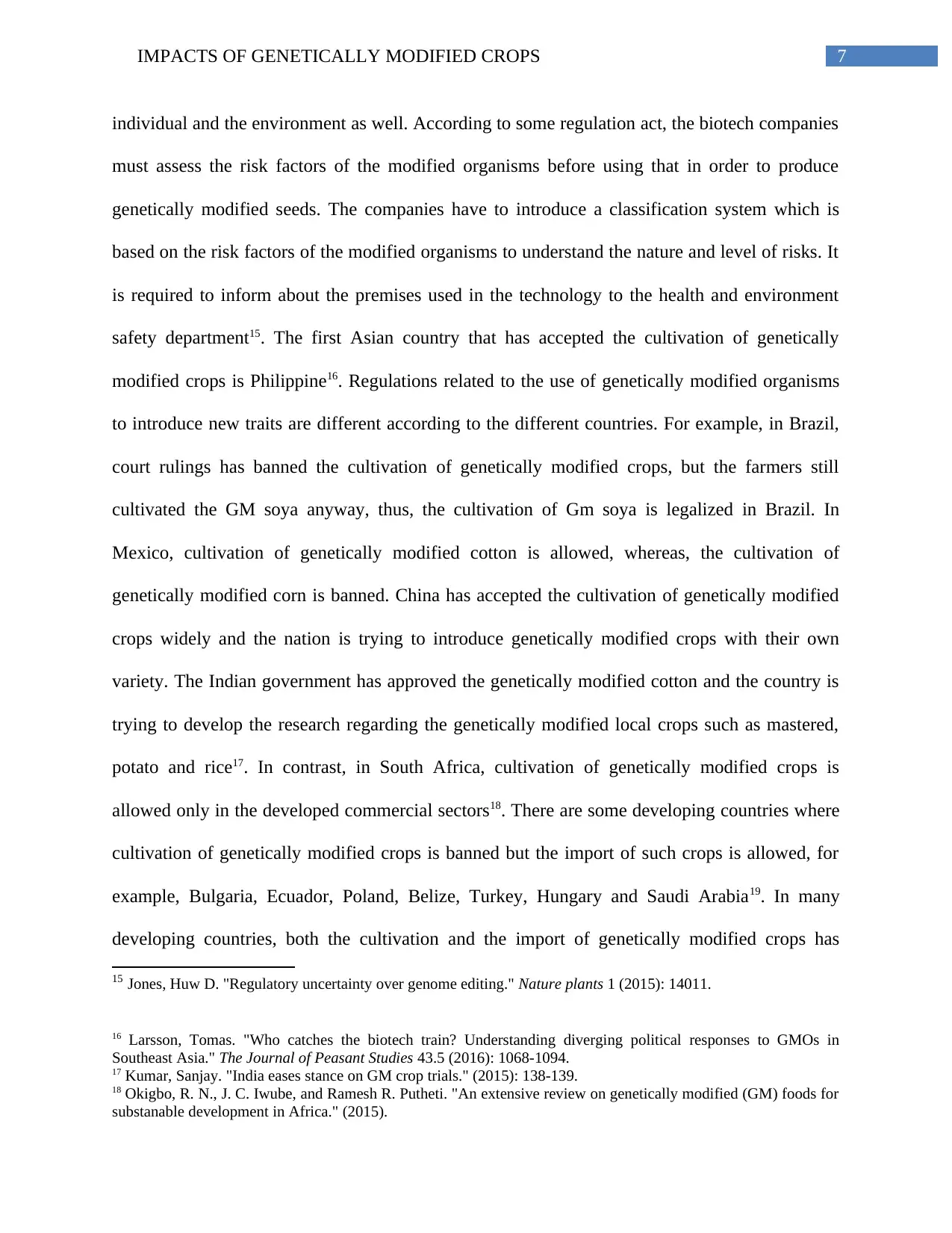
7IMPACTS OF GENETICALLY MODIFIED CROPS
individual and the environment as well. According to some regulation act, the biotech companies
must assess the risk factors of the modified organisms before using that in order to produce
genetically modified seeds. The companies have to introduce a classification system which is
based on the risk factors of the modified organisms to understand the nature and level of risks. It
is required to inform about the premises used in the technology to the health and environment
safety department15. The first Asian country that has accepted the cultivation of genetically
modified crops is Philippine16. Regulations related to the use of genetically modified organisms
to introduce new traits are different according to the different countries. For example, in Brazil,
court rulings has banned the cultivation of genetically modified crops, but the farmers still
cultivated the GM soya anyway, thus, the cultivation of Gm soya is legalized in Brazil. In
Mexico, cultivation of genetically modified cotton is allowed, whereas, the cultivation of
genetically modified corn is banned. China has accepted the cultivation of genetically modified
crops widely and the nation is trying to introduce genetically modified crops with their own
variety. The Indian government has approved the genetically modified cotton and the country is
trying to develop the research regarding the genetically modified local crops such as mastered,
potato and rice17. In contrast, in South Africa, cultivation of genetically modified crops is
allowed only in the developed commercial sectors18. There are some developing countries where
cultivation of genetically modified crops is banned but the import of such crops is allowed, for
example, Bulgaria, Ecuador, Poland, Belize, Turkey, Hungary and Saudi Arabia19. In many
developing countries, both the cultivation and the import of genetically modified crops has
15 Jones, Huw D. "Regulatory uncertainty over genome editing." Nature plants 1 (2015): 14011.
16 Larsson, Tomas. "Who catches the biotech train? Understanding diverging political responses to GMOs in
Southeast Asia." The Journal of Peasant Studies 43.5 (2016): 1068-1094.
17 Kumar, Sanjay. "India eases stance on GM crop trials." (2015): 138-139.
18 Okigbo, R. N., J. C. Iwube, and Ramesh R. Putheti. "An extensive review on genetically modified (GM) foods for
substanable development in Africa." (2015).
individual and the environment as well. According to some regulation act, the biotech companies
must assess the risk factors of the modified organisms before using that in order to produce
genetically modified seeds. The companies have to introduce a classification system which is
based on the risk factors of the modified organisms to understand the nature and level of risks. It
is required to inform about the premises used in the technology to the health and environment
safety department15. The first Asian country that has accepted the cultivation of genetically
modified crops is Philippine16. Regulations related to the use of genetically modified organisms
to introduce new traits are different according to the different countries. For example, in Brazil,
court rulings has banned the cultivation of genetically modified crops, but the farmers still
cultivated the GM soya anyway, thus, the cultivation of Gm soya is legalized in Brazil. In
Mexico, cultivation of genetically modified cotton is allowed, whereas, the cultivation of
genetically modified corn is banned. China has accepted the cultivation of genetically modified
crops widely and the nation is trying to introduce genetically modified crops with their own
variety. The Indian government has approved the genetically modified cotton and the country is
trying to develop the research regarding the genetically modified local crops such as mastered,
potato and rice17. In contrast, in South Africa, cultivation of genetically modified crops is
allowed only in the developed commercial sectors18. There are some developing countries where
cultivation of genetically modified crops is banned but the import of such crops is allowed, for
example, Bulgaria, Ecuador, Poland, Belize, Turkey, Hungary and Saudi Arabia19. In many
developing countries, both the cultivation and the import of genetically modified crops has
15 Jones, Huw D. "Regulatory uncertainty over genome editing." Nature plants 1 (2015): 14011.
16 Larsson, Tomas. "Who catches the biotech train? Understanding diverging political responses to GMOs in
Southeast Asia." The Journal of Peasant Studies 43.5 (2016): 1068-1094.
17 Kumar, Sanjay. "India eases stance on GM crop trials." (2015): 138-139.
18 Okigbo, R. N., J. C. Iwube, and Ramesh R. Putheti. "An extensive review on genetically modified (GM) foods for
substanable development in Africa." (2015).
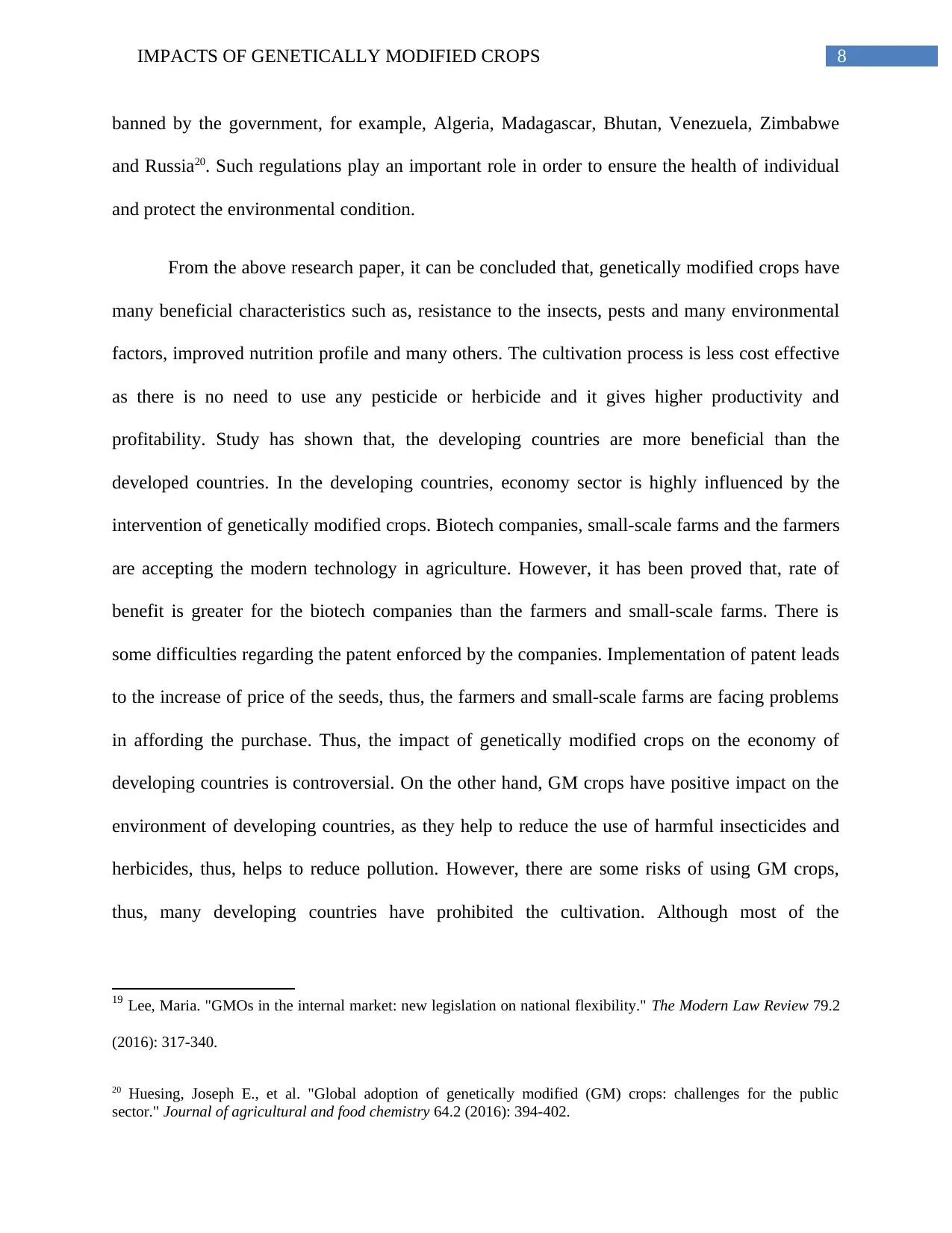
8IMPACTS OF GENETICALLY MODIFIED CROPS
banned by the government, for example, Algeria, Madagascar, Bhutan, Venezuela, Zimbabwe
and Russia20. Such regulations play an important role in order to ensure the health of individual
and protect the environmental condition.
From the above research paper, it can be concluded that, genetically modified crops have
many beneficial characteristics such as, resistance to the insects, pests and many environmental
factors, improved nutrition profile and many others. The cultivation process is less cost effective
as there is no need to use any pesticide or herbicide and it gives higher productivity and
profitability. Study has shown that, the developing countries are more beneficial than the
developed countries. In the developing countries, economy sector is highly influenced by the
intervention of genetically modified crops. Biotech companies, small-scale farms and the farmers
are accepting the modern technology in agriculture. However, it has been proved that, rate of
benefit is greater for the biotech companies than the farmers and small-scale farms. There is
some difficulties regarding the patent enforced by the companies. Implementation of patent leads
to the increase of price of the seeds, thus, the farmers and small-scale farms are facing problems
in affording the purchase. Thus, the impact of genetically modified crops on the economy of
developing countries is controversial. On the other hand, GM crops have positive impact on the
environment of developing countries, as they help to reduce the use of harmful insecticides and
herbicides, thus, helps to reduce pollution. However, there are some risks of using GM crops,
thus, many developing countries have prohibited the cultivation. Although most of the
19 Lee, Maria. "GMOs in the internal market: new legislation on national flexibility." The Modern Law Review 79.2
(2016): 317-340.
20 Huesing, Joseph E., et al. "Global adoption of genetically modified (GM) crops: challenges for the public
sector." Journal of agricultural and food chemistry 64.2 (2016): 394-402.
banned by the government, for example, Algeria, Madagascar, Bhutan, Venezuela, Zimbabwe
and Russia20. Such regulations play an important role in order to ensure the health of individual
and protect the environmental condition.
From the above research paper, it can be concluded that, genetically modified crops have
many beneficial characteristics such as, resistance to the insects, pests and many environmental
factors, improved nutrition profile and many others. The cultivation process is less cost effective
as there is no need to use any pesticide or herbicide and it gives higher productivity and
profitability. Study has shown that, the developing countries are more beneficial than the
developed countries. In the developing countries, economy sector is highly influenced by the
intervention of genetically modified crops. Biotech companies, small-scale farms and the farmers
are accepting the modern technology in agriculture. However, it has been proved that, rate of
benefit is greater for the biotech companies than the farmers and small-scale farms. There is
some difficulties regarding the patent enforced by the companies. Implementation of patent leads
to the increase of price of the seeds, thus, the farmers and small-scale farms are facing problems
in affording the purchase. Thus, the impact of genetically modified crops on the economy of
developing countries is controversial. On the other hand, GM crops have positive impact on the
environment of developing countries, as they help to reduce the use of harmful insecticides and
herbicides, thus, helps to reduce pollution. However, there are some risks of using GM crops,
thus, many developing countries have prohibited the cultivation. Although most of the
19 Lee, Maria. "GMOs in the internal market: new legislation on national flexibility." The Modern Law Review 79.2
(2016): 317-340.
20 Huesing, Joseph E., et al. "Global adoption of genetically modified (GM) crops: challenges for the public
sector." Journal of agricultural and food chemistry 64.2 (2016): 394-402.
⊘ This is a preview!⊘
Do you want full access?
Subscribe today to unlock all pages.

Trusted by 1+ million students worldwide

9IMPACTS OF GENETICALLY MODIFIED CROPS
developing countries have accepted the process trough some regulation of using GMO in order to
ensure the safety of health and environment.
developing countries have accepted the process trough some regulation of using GMO in order to
ensure the safety of health and environment.
Paraphrase This Document
Need a fresh take? Get an instant paraphrase of this document with our AI Paraphraser
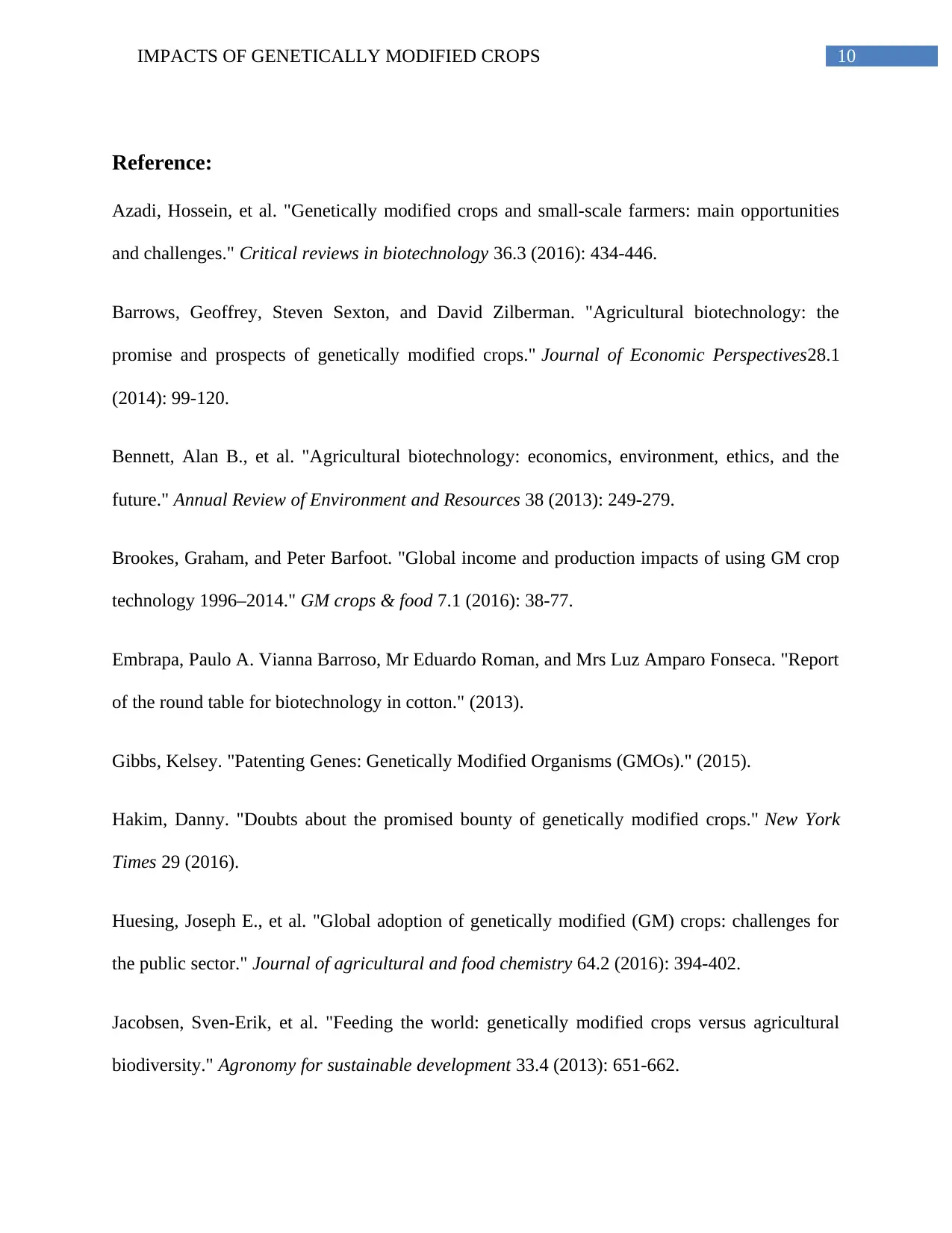
10IMPACTS OF GENETICALLY MODIFIED CROPS
Reference:
Azadi, Hossein, et al. "Genetically modified crops and small-scale farmers: main opportunities
and challenges." Critical reviews in biotechnology 36.3 (2016): 434-446.
Barrows, Geoffrey, Steven Sexton, and David Zilberman. "Agricultural biotechnology: the
promise and prospects of genetically modified crops." Journal of Economic Perspectives28.1
(2014): 99-120.
Bennett, Alan B., et al. "Agricultural biotechnology: economics, environment, ethics, and the
future." Annual Review of Environment and Resources 38 (2013): 249-279.
Brookes, Graham, and Peter Barfoot. "Global income and production impacts of using GM crop
technology 1996–2014." GM crops & food 7.1 (2016): 38-77.
Embrapa, Paulo A. Vianna Barroso, Mr Eduardo Roman, and Mrs Luz Amparo Fonseca. "Report
of the round table for biotechnology in cotton." (2013).
Gibbs, Kelsey. "Patenting Genes: Genetically Modified Organisms (GMOs)." (2015).
Hakim, Danny. "Doubts about the promised bounty of genetically modified crops." New York
Times 29 (2016).
Huesing, Joseph E., et al. "Global adoption of genetically modified (GM) crops: challenges for
the public sector." Journal of agricultural and food chemistry 64.2 (2016): 394-402.
Jacobsen, Sven-Erik, et al. "Feeding the world: genetically modified crops versus agricultural
biodiversity." Agronomy for sustainable development 33.4 (2013): 651-662.
Reference:
Azadi, Hossein, et al. "Genetically modified crops and small-scale farmers: main opportunities
and challenges." Critical reviews in biotechnology 36.3 (2016): 434-446.
Barrows, Geoffrey, Steven Sexton, and David Zilberman. "Agricultural biotechnology: the
promise and prospects of genetically modified crops." Journal of Economic Perspectives28.1
(2014): 99-120.
Bennett, Alan B., et al. "Agricultural biotechnology: economics, environment, ethics, and the
future." Annual Review of Environment and Resources 38 (2013): 249-279.
Brookes, Graham, and Peter Barfoot. "Global income and production impacts of using GM crop
technology 1996–2014." GM crops & food 7.1 (2016): 38-77.
Embrapa, Paulo A. Vianna Barroso, Mr Eduardo Roman, and Mrs Luz Amparo Fonseca. "Report
of the round table for biotechnology in cotton." (2013).
Gibbs, Kelsey. "Patenting Genes: Genetically Modified Organisms (GMOs)." (2015).
Hakim, Danny. "Doubts about the promised bounty of genetically modified crops." New York
Times 29 (2016).
Huesing, Joseph E., et al. "Global adoption of genetically modified (GM) crops: challenges for
the public sector." Journal of agricultural and food chemistry 64.2 (2016): 394-402.
Jacobsen, Sven-Erik, et al. "Feeding the world: genetically modified crops versus agricultural
biodiversity." Agronomy for sustainable development 33.4 (2013): 651-662.
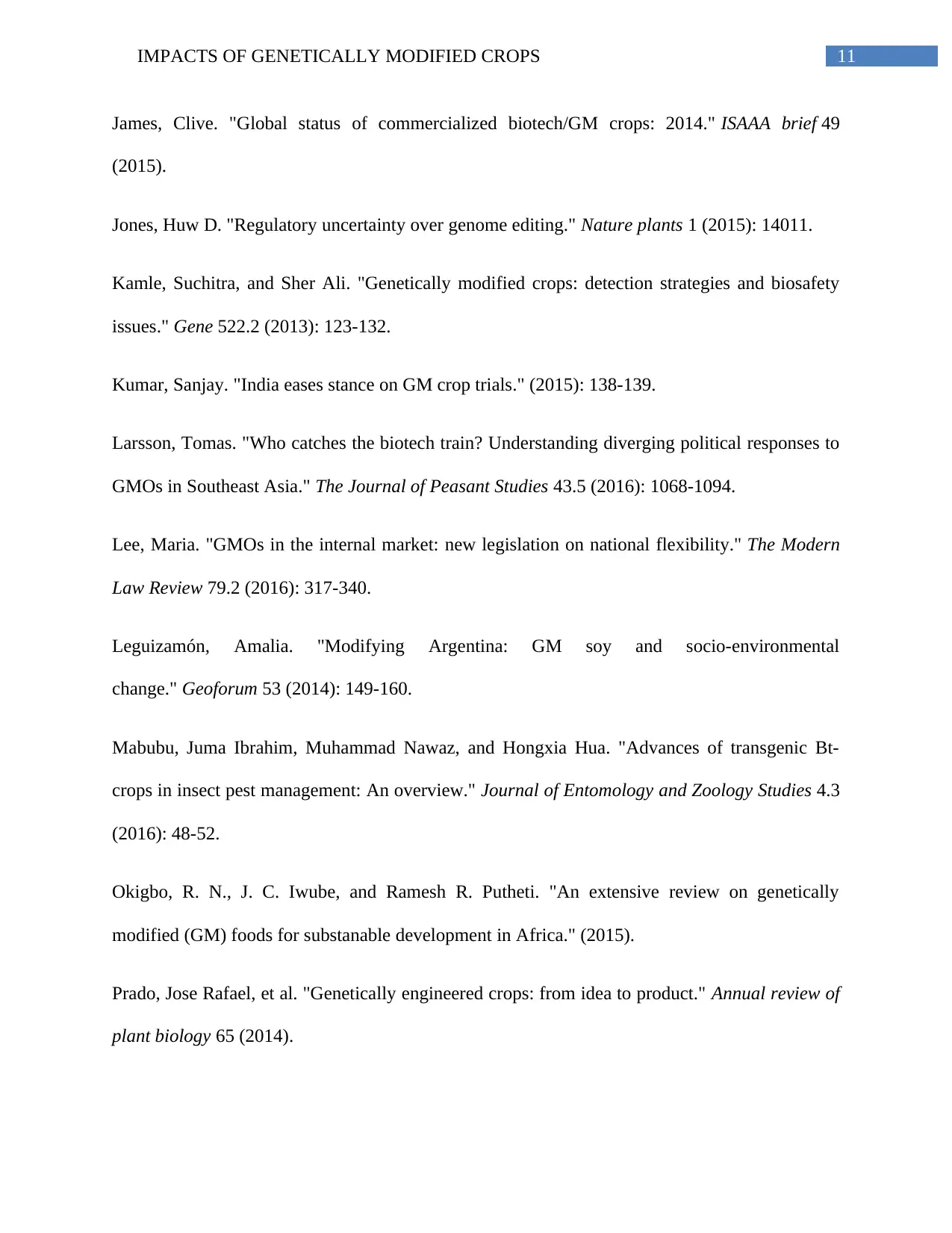
11IMPACTS OF GENETICALLY MODIFIED CROPS
James, Clive. "Global status of commercialized biotech/GM crops: 2014." ISAAA brief 49
(2015).
Jones, Huw D. "Regulatory uncertainty over genome editing." Nature plants 1 (2015): 14011.
Kamle, Suchitra, and Sher Ali. "Genetically modified crops: detection strategies and biosafety
issues." Gene 522.2 (2013): 123-132.
Kumar, Sanjay. "India eases stance on GM crop trials." (2015): 138-139.
Larsson, Tomas. "Who catches the biotech train? Understanding diverging political responses to
GMOs in Southeast Asia." The Journal of Peasant Studies 43.5 (2016): 1068-1094.
Lee, Maria. "GMOs in the internal market: new legislation on national flexibility." The Modern
Law Review 79.2 (2016): 317-340.
Leguizamón, Amalia. "Modifying Argentina: GM soy and socio-environmental
change." Geoforum 53 (2014): 149-160.
Mabubu, Juma Ibrahim, Muhammad Nawaz, and Hongxia Hua. "Advances of transgenic Bt-
crops in insect pest management: An overview." Journal of Entomology and Zoology Studies 4.3
(2016): 48-52.
Okigbo, R. N., J. C. Iwube, and Ramesh R. Putheti. "An extensive review on genetically
modified (GM) foods for substanable development in Africa." (2015).
Prado, Jose Rafael, et al. "Genetically engineered crops: from idea to product." Annual review of
plant biology 65 (2014).
James, Clive. "Global status of commercialized biotech/GM crops: 2014." ISAAA brief 49
(2015).
Jones, Huw D. "Regulatory uncertainty over genome editing." Nature plants 1 (2015): 14011.
Kamle, Suchitra, and Sher Ali. "Genetically modified crops: detection strategies and biosafety
issues." Gene 522.2 (2013): 123-132.
Kumar, Sanjay. "India eases stance on GM crop trials." (2015): 138-139.
Larsson, Tomas. "Who catches the biotech train? Understanding diverging political responses to
GMOs in Southeast Asia." The Journal of Peasant Studies 43.5 (2016): 1068-1094.
Lee, Maria. "GMOs in the internal market: new legislation on national flexibility." The Modern
Law Review 79.2 (2016): 317-340.
Leguizamón, Amalia. "Modifying Argentina: GM soy and socio-environmental
change." Geoforum 53 (2014): 149-160.
Mabubu, Juma Ibrahim, Muhammad Nawaz, and Hongxia Hua. "Advances of transgenic Bt-
crops in insect pest management: An overview." Journal of Entomology and Zoology Studies 4.3
(2016): 48-52.
Okigbo, R. N., J. C. Iwube, and Ramesh R. Putheti. "An extensive review on genetically
modified (GM) foods for substanable development in Africa." (2015).
Prado, Jose Rafael, et al. "Genetically engineered crops: from idea to product." Annual review of
plant biology 65 (2014).
⊘ This is a preview!⊘
Do you want full access?
Subscribe today to unlock all pages.

Trusted by 1+ million students worldwide
1 out of 13
Related Documents
Your All-in-One AI-Powered Toolkit for Academic Success.
+13062052269
info@desklib.com
Available 24*7 on WhatsApp / Email
![[object Object]](/_next/static/media/star-bottom.7253800d.svg)
Unlock your academic potential
Copyright © 2020–2025 A2Z Services. All Rights Reserved. Developed and managed by ZUCOL.





